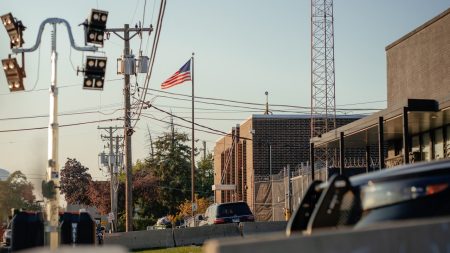The Guardians of Justice: Independent Courts Navigate Global Political Polarization
In an Era of Division, Judicial Independence Faces Unprecedented Challenges
In courtrooms across the globe, from stately marble chambers to humble provincial buildings, judges are increasingly finding themselves at the epicenter of societal fractures. As political polarization intensifies in democracies worldwide, judicial independence—once considered a foundational pillar of democratic governance—faces mounting pressure from all sides of the political spectrum. This growing tension between judicial autonomy and political influence has profound implications not only for the rule of law but for the very fabric of democratic societies struggling to maintain cohesion in increasingly divided times.
The phenomenon transcends geographic boundaries and political systems. In the United States, Supreme Court justices face intense scrutiny and questions about their impartiality, with public approval of the high court reaching historic lows. Across Europe, countries like Poland and Hungary have witnessed systematic attempts to bring courts under political control, triggering unprecedented responses from European Union institutions. Meanwhile, in emerging democracies across Asia, Africa, and Latin America, judicial independence often hangs by a thread as populist leaders seek to consolidate power by undermining institutional checks and balances.
“The judiciary was designed to be counter-majoritarian in many respects,” explains Dr. Elena Martínez, professor of constitutional law at Columbia University. “Judges are tasked with upholding constitutional principles and protecting individual rights, even when those decisions may be unpopular with the majority. But in today’s hyperpolarized environment, any ruling on contentious issues is immediately perceived through a partisan lens, undermining public confidence in judicial neutrality.”
Historical Context: The Evolution of Judicial Independence
The concept of an independent judiciary has deep historical roots, evolving from early efforts to separate powers and establish checks and balances within government. In the Anglo-American legal tradition, milestones like the 1701 Act of Settlement in England established crucial judicial protections, including tenure during good behavior and fixed salaries—innovations later incorporated into the U.S. Constitution and many others worldwide.
Throughout the 20th century, as democracy expanded globally, judicial independence became a cornerstone of international governance standards. The United Nations Basic Principles on the Independence of the Judiciary, adopted in 1985, codified these principles internationally, establishing benchmarks for judicial autonomy regardless of a nation’s political system or cultural context.
“What we’re witnessing today isn’t entirely unprecedented,” notes Justice Richard Goldstone, former Constitutional Court judge in post-apartheid South Africa. “Courts have always faced pressure when ruling on politically charged cases. What’s different now is the systematic nature of attacks on judicial legitimacy and the technological amplification of these criticisms through social media and partisan news outlets.”
Indeed, historical perspective reveals cyclical patterns of tension between courts and political forces. The American “court-packing” controversy under President Franklin Roosevelt in the 1930s, when he threatened to expand the Supreme Court after it struck down key New Deal legislation, offers one notable example. However, contemporary challenges appear more fundamental, questioning not just individual rulings but the very legitimacy of courts as neutral arbiters.
The Global Landscape: From Established Democracies to Emerging Systems
In established democracies, the erosion of judicial independence often occurs subtly. Politicians may not directly attack court structures but instead undermine public confidence through rhetoric casting judges as partisan actors or “activists.” In the United States, the increasingly contentious Supreme Court nomination process has transformed into political theater, with ideological litmus tests replacing evaluations of legal acumen or judicial temperament.
“The politicization of judicial appointments creates a self-reinforcing cycle,” argues Professor James Hawkins of Stanford Law School. “When judges are selected primarily for their presumed ideological leanings, it becomes increasingly difficult for the public to view them as impartial. This perception problem persists even when judges demonstrate independence from the political forces that appointed them.”
The situation appears even more precarious in newer democracies. In Poland, the ruling Law and Justice party implemented sweeping judicial reforms that gave politicians unprecedented control over judicial appointments and discipline. Similar patterns emerged in Hungary, where Prime Minister Viktor Orbán’s government has systematically consolidated control over courts. In Brazil, former President Jair Bolsonaro frequently clashed with the Supreme Federal Court, threatening institutional stability during crucial democratic moments.
Meanwhile, in countries like Turkey, Venezuela, and the Philippines, executive power has expanded at the judiciary’s expense, often with popular support from citizens frustrated with perceived institutional ineffectiveness or corruption. This pattern reveals a troubling paradox: democratic majorities sometimes willingly sacrifice judicial independence in pursuit of other political goals, not fully appreciating its essential role in protecting minority rights and constitutional guarantees.
Technology, Media, and the Court of Public Opinion
The digital revolution has fundamentally altered how judicial decisions reach and are interpreted by the public. Complex legal rulings, once filtered through professional legal journalists with specialized knowledge, now enter public discourse through social media snippets, partisan commentary, and algorithmic news feeds that prioritize outrage over nuance.
“Judges today operate in what we might call a ‘transparency paradox,'” explains Dr. Sophia Williams, who researches digital media and legal institutions at Oxford University. “Their work is more visible than ever before, yet public understanding of judicial reasoning and legal principles may actually be declining. Most citizens encounter court decisions not through reading opinions but through highly politicized interpretations of those opinions.”
This technological transformation coincides with deeper changes in media landscapes. The decline of traditional journalism, particularly specialized legal reporting, has created information vacuums often filled by partisan outlets more interested in framing judicial decisions as political victories or defeats than explaining legal reasoning. Meanwhile, judges themselves remain constrained by professional ethics from defending their decisions in public forums, creating asymmetric communication dynamics.
Some courts have responded by modernizing their communications strategies. The United Kingdom Supreme Court now livestreams proceedings and provides judgment summaries in accessible language. Canada’s Supreme Court actively engages on social media platforms, while courts in Australia and New Zealand have developed comprehensive public education initiatives. These efforts represent recognition that judicial legitimacy in the digital age requires not just independence but also transparency and communication.
“The challenge for courts is maintaining their distinctive institutional role while adapting to new communication realities,” notes Chief Justice Maria Rodriguez of Argentina’s Supreme Court. “We must explain our decisions clearly without being drawn into political battles that would compromise our independence. It’s a delicate balance few judiciaries were prepared to navigate.”
Judges Under Pressure: The Human Dimension
Behind abstract discussions of judicial independence lie human stories—judges facing personal and professional pressures while striving to uphold their constitutional responsibilities. In countries experiencing democratic backsliding, this may include direct intimidation, salary manipulation, or professional ostracism. Even in stable democracies, judges increasingly face personal threats, online harassment, and intense scrutiny of their private lives.
Judge Thomas Keller, who serves on a federal appellate court in the United States, describes the psychological toll: “When I took the bench fifteen years ago, I expected controversy around certain decisions—that comes with the territory. What I didn’t anticipate was having protesters outside my home, threats against my family, or seeing my face on partisan websites alongside accusations of corruption or bias simply because I followed legal precedent in a politically charged case.”
The pressure extends beyond high-profile constitutional courts to trial judges handling everyday cases. In regions where organized crime, corruption, or political violence flourish, judges make life-altering decisions knowing their personal safety may be at risk. In Mexico, Colombia, and parts of Central America, judges overseeing narcotics cases often require armed security details. In India, judges handling corruption cases involving powerful politicians report subtle and not-so-subtle forms of pressure.
These challenges have concrete consequences for judicial diversity and recruitment. Legal scholars note concerning trends in judicial retention and recruitment, with experienced attorneys increasingly reluctant to pursue judicial careers given the heightened scrutiny, safety concerns, and often significant salary reductions compared to private practice. This threatens to narrow the pool of judicial candidates at precisely the moment when diverse perspectives and broad experience are most needed on the bench.
Defending Judicial Independence: Institutional Innovations and Democratic Resilience
Despite these challenges, promising innovations are emerging worldwide to protect judicial independence while maintaining democratic accountability. Some focus on structural reforms to judicial selection processes. Germany’s system of supermajority parliamentary approval for constitutional court judges, requiring cross-partisan consensus, offers one model. South Africa’s Judicial Service Commission, which includes representatives from the legal profession alongside political appointees, represents another approach to balancing democratic input with professional standards.
Other initiatives target financial independence. Several countries have established fixed percentages of national budgets allocated to judiciary operations, insulating courts from funding threats. Technology also offers potential solutions, with blockchain-based systems for random case assignment reducing opportunities for manipulation in countries where case allocation has been used to influence outcomes.
Civil society organizations have emerged as crucial defenders of judicial independence, monitoring court systems and raising international awareness when independence is threatened. The International Commission of Jurists, the International Association of Judges, and regional organizations like the European Association of Judges provide crucial support networks for judges facing political pressure.
“The struggle for judicial independence is ultimately a struggle for constitutional democracy itself,” reflects Justice Aharon Barak, former President of the Israeli Supreme Court and globally respected jurist. “Independent courts alone cannot save democracy, but democracy cannot survive without them. They provide essential forums where power can be challenged, rights defended, and the rule of law maintained even in divided societies.”
As societies worldwide navigate intense polarization, the position of independent courts remains precarious yet essential. Their ability to render impartial justice based on law rather than political calculation provides a crucial mechanism for peaceful conflict resolution in divided societies. While the challenges facing judicial independence are significant, history suggests democratic institutions can prove remarkably resilient when citizens recognize and defend their fundamental value. The future of constitutional governance may well depend on whether societies can recognize that independent courts, even when delivering unpopular decisions, remain indispensable guardians of democratic values and individual rights in troubled times.










